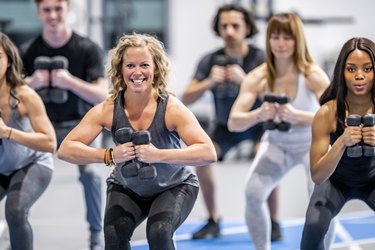
The pros and cons of squats are numerous: squats strengthen the buttocks, hips and thighs, yet they may injure the lower back or other parts of the body when performed improperly. Learn how to do a proper squat, as well as the advantages and risks involved.
The Proper Squat
Video of the Day
According to Harvard Medical School, there's more than one way to do a classic squat: in the neutral stance, with feet shoulder-width apart; and wide stance, with your feet wider apart than your shoulders, pointed outward at a 45 degree angle.
Video of the Day
With your back straight, eyes forward and feet firmly on the ground, slowly push your hips and buttocks back — imagine sitting in a chair. Be sure to keep your knees over your ankles. You can hold dumbbells, barbells or kettlebells for extra resistance.
If you're using only bodyweight you can reach forward with your arms, though this is optional. Hold for two to four seconds, then slowly come back up to standing position. Repeat this movement for a given number of repetitions and sets.
A commonly held misconception, according to the American Council on Exercise (ACE), is that when doing squats, the knees should not go past the toes. Ideally, you would want to be positioned so that your weight is evenly distributed on the three prominent contact points of the feet: the heels, inner balls and outer balls. This position will help the knees fall into place.
ACE advises looking to more than just the knee position for doing a proper squat. Other factors, such as overall good form, a logical progression strategy and sufficient warm-ups, will decrease the risk of injury and negative side effects of squats.
Read more: Benefits of Squats
Side Effects of Squats
The American College of Sports Medicine (ACSM) points to the low back as an area of concern when doing squats. If a squat is not executed properly, then too much stress on the lower back can cause injury. The two most likely causes of injury on the back while squatting are lifting excessive weight and leaning too far forward, so the strain is put on the back instead of the legs and hips.
A few things that will help lower the strain on the back include maintaining an upright posture while performing squats and keeping the abdominals strong to protect the spine. Moreover, it's important to maintain a strong torso musculature to protect the spine.
The disadvantages of squats arise mostly as a result of form not being executed properly or from performing squats while previously injured. Though interestingly, ACSM explains that not only was it found that squats do not negatively affect knee stability, but they can also be performed by athletes rehabilitating injured knees. That said, there are situations when, during knee healing, squats should be avoided.
Read more: The 30-Day Squat Challenge
A Few Squat Variations
There are a number of variations on the classic squat that you can try once you've mastered the proper squat form. ACE recommends different variations, including:
Move 1: Dumbbell Squat
- Grip two dumbbells below your chin, elbows bent, palms facing outward.
- Lower into a squat position to the point where your elbows touch or nearly touch your knees.
Move 2: Split Squat
- Hold dumbbells in each hand, arms straight and palms facing inward.
- Stand with one foot in front of the other.
- Lower the back knee down, nearly to the mat and rest for a few seconds.
- Come back to standing position and squeeze the glutes on the way up.
- Do your repetitions on one side before switching.
Move 3: Jump Squat
Jump squats are a great way to mix in cardio with your strength training. Do a normal wide-stance squat, but jump, with your arms straight up, extended above your head, when you come into standing position. Start and finish the jump in a squatting position.
Advantages of Squats
While there are certain negative effects of squats, especially when executed improperly, there are also several positive strengthening effects of squats on buttocks, hips and thighs.
One 2016 study in the Journal of Sports Science and Medicine found that squat training improved several athletic performance tasks simultaneously. Eight weeks of jump squat training by subjects resulted in significant improvements in a variety of workouts.
- ACE: "Squat Variations: 6 Effective Squat Variations to Try"
- Harvard Medical School: "The Lowdowns on Squats"
- ACE: "Myths and Misconceptions - Lunges and Squats"
- Journal of Sports Science and Medicine: "Improved Maximum Strength, Vertical Jump and Sprint Performance after 8 Weeks of Jump Squat Training with Individualized Loads"
- ACSM: "Safety of the Squat Exercise"